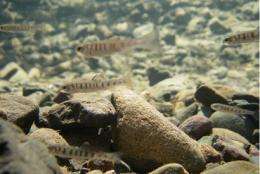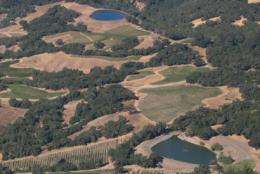Steelhead trout lose out when water is low in wine country

(������Ƶ) -- The competition between farmers and fish for precious water in California is intensifying in wine country, suggests a new study by biologists at the University of California, Berkeley.
The findings, published in the May issue of the journal Transactions of the American Fisheries Society, link higher death rates for threatened juvenile steelhead trout with low water levels in the summer and the amount of vineyard acreage upstream.
The researchers found that juvenile steelhead trout are particularly at risk during the dry summer season typical of California’s Mediterranean climate. Of the juvenile steelhead trout present in June, on average only 30 percent survived to the late summer. In years with higher rainfall and in watersheds with less vineyard land use, the survival of juvenile trout over the summer was significantly higher.
The researchers pointed out that summer stream flow has been inadequately addressed in salmon and trout conservation efforts. Previous studies have highlighted other limiting factors such as habitat degradation and water quality, but here researchers documented the importance of water quantity for restoring threatened populations.
“Nearly all of California’s salmon and trout populations are on the path to extinction and if we’re going to bring these fish back to healthy levels, we have to change the way we manage our water,” said lead author Theodore Grantham, a recent Ph.D. graduate from UC Berkeley’s Department of Environmental Science, Policy and Management (ESPM). “Water withdrawals for agricultural uses can reduce or eliminate the limited amount of habitat available to sustain these cold-water fish through the summer. I don’t suggest we get rid of vineyards, but we do need to focus our attention on water management strategies that reduce summer water use. I believe we can protect flows for fish and still have our glass of wine.”

Steelhead trout (Oncorhynchus mykiss), historically found throughout the North Pacific Ocean, are an ocean-going, or anadromous, form of rainbow trout of the salmon family. Like salmon, steelhead trout migrate from freshwater streams to the ocean before returning to their birthplace to spawn. Steelhead trout in Southern California and the upper Columbia River are endangered, and several other populations, including those in Northern California, are threatened.
While drought conditions clearly have an impact on water levels in streams, the study authors highlighted the role played by regional agriculture. Previous studies in Sonoma County have shown that stream flow drops when pumps draw water for vineyards. In addition to using water for irrigation, Grantham noted that farmers often pump water from streams to protect vines when freezing temperatures occur in the spring. Overhead sprinklers coat vines in a layer of water that quickly freezes to create a thermal barrier, preventing damage to the vines.
“Because frost threatens all of the region’s vineyards at the same time, there can be an incredible peak demand for water during a concentrated two to three days,” said Grantham, who is now a postdoctoral researcher at the Center for Watershed Sciences at UC Davis. “During a bad frost year, as much water could be used in just two weeks during the spring as in an entire season for standard irrigation needs.”
One possible solution, Grantham noted, is establishing small off-stream reservoirs to store water during times of high rainfall. Vineyards would be able to draw from these water stores during low-flow periods rather than directly from streams.
The new analysis is based upon nine years of fish count data taken from nine streams in Sonoma County, allowing researchers to account for year-to-year variability in precipitation and differences in land use.
The researchers acknowledged that there are many environmental factors that influence populations of salmon and steelhead trout, including ocean conditions, fisheries and habitat degradation, so isolating which factors are causing problems, and to what extent, is extremely difficult.
“This is the first scientific publication on how vineyards and summer stream flows relate to fish survivorship in California’s tributary streams,” said study principal investigator Adina Merenlender, cooperative extension specialist in ESPM. “It is the closest we have to substantiating claims by resource agencies and environmental organizations that juvenile salmon are being impacted by low flows during the summer and survive better with more flow. These findings will help inform an important environmental issue in California that is disturbing to conservationists and grape growers alike.”
Other co-authors of the study are David Newburn, now an assistant professor at the University of Maryland’s Department of Agricultural and Resource Economics, and Michael McCarthy, a research fellow at the University of Melbourne’s School of Botany.
The Environmental Protection Agency and the National Science Foundation helped support this research.
Provided by University of California - Berkeley
















